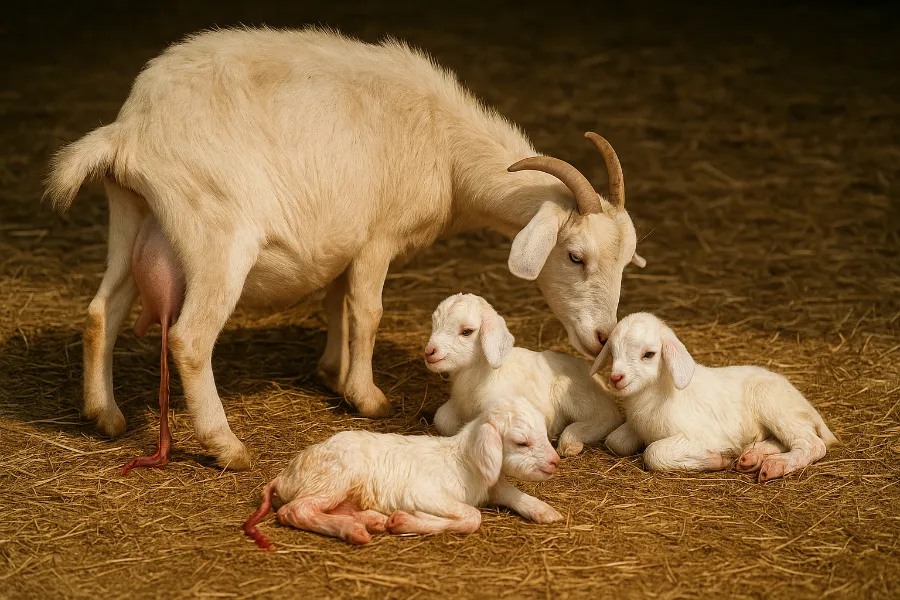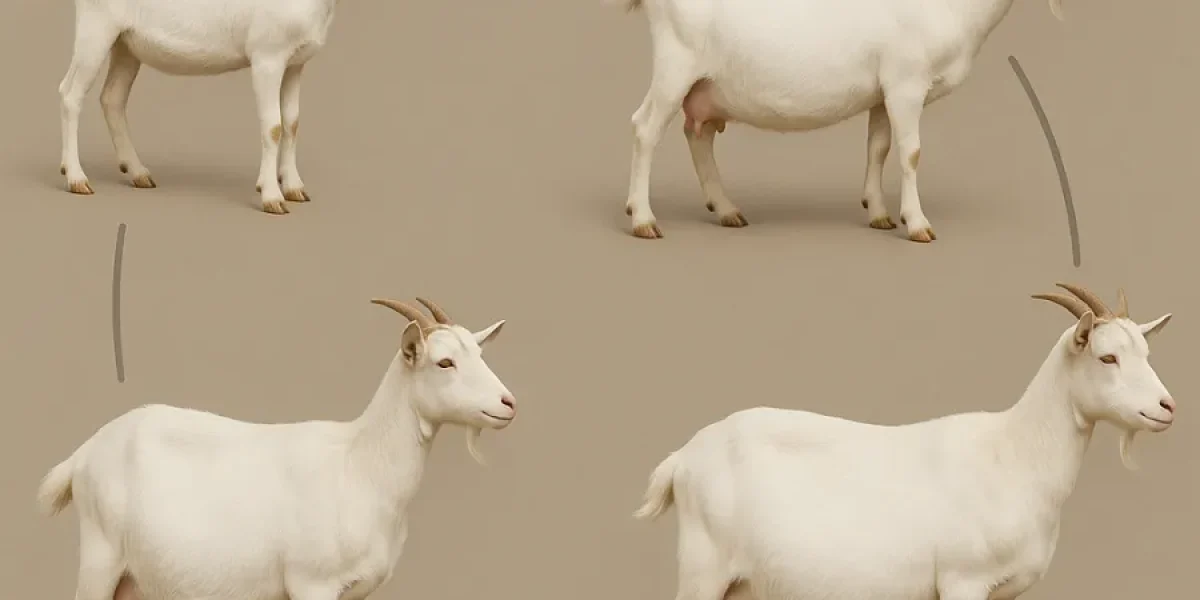When I first started breeding goats, I thought it would be simple — breed a doe, wait five months, and welcome cute, wobbly kids. But as I learned quickly, goat pregnancy is a beautiful mix of biology, patience, and intuition. Each day of the gestation period brings new signs, challenges, and lessons — if you know what to watch for.
Understanding how your doe changes from the first day of breeding until the moment she delivers is what separates smooth kiddings from stressful nights. So today, I’m walking you through everything I’ve learned about goat pregnancy — from gestation cycle to labor signs, feed, minerals, and care — written in a way that’s both personal and practical for any goat owner or homesteader.
Goat Gestation Period
The goat gestation period lasts about 150 days, or roughly five months — but no two does follow the exact same schedule. Some kid early at 145 days, and others hold out closer to 155.
I always note my breeding date the moment the buck and doe are together. That’s Day 0 — the start of everything. From there, I count forward 150 days on my calendar and circle the due date in bright red.
Here’s what that timeline usually looks like:
- Month 1: Conception and implantation
- Month 2: Early fetal development
- Month 3: Visible belly growth
- Month 4: Rapid fetal and udder development
- Month 5: Nesting and labor signs
Understanding this rhythm helps me predict when to adjust feed, add supplements, or start prepping the kidding pen. It’s the foundation of managing a healthy pregnancy.
Goat Gestation Cycle
Every doe follows her own goat gestation cycle, but certain patterns repeat with amazing consistency.
During the first month, not much seems to change. The embryos are settling into the uterus, and the doe usually acts normal. Around day 30–45, though, things begin shifting. Her hormones stabilize, her appetite increases slightly, and her energy balances out.
By month three, that unmistakable roundness appears — the kind that makes you smile every time she waddles toward the feeder. By month four, her sides fill out, her udder starts forming, and her breathing slows on hot days.
The last few weeks are when I start watching her closely. Her belly tightens, then drops slightly, her ligaments soften, and I know we’re nearing the end of her gestation cycle — and the beginning of something new.
Goat Labor Signs
I’ve learned that watching for goat labor signs is part science, part instinct. Every doe gives clues — you just have to pay attention.
Here’s what I always look for:
A few days before labor:
- Her ligaments near the tailhead feel soft, like warm jelly.
- The vulva swells slightly and looks moist.
- She becomes restless or isolates herself from the herd.
- Her udder fills out tight and shiny.
Within hours of labor:
- She paws at the bedding or circles repeatedly.
- Mucus discharge appears — clear or milky strands.
- Appetite drops suddenly.
- She lies down, grunts softly, and stands back up.
When contractions start, you’ll see her abdomen ripple — and within an hour or two, the amniotic sac appears.
That’s when I stop everything else and stay close.
Once you see two little hooves and a nose, you know she’s doing perfectly. If you don’t, it’s time to gently check positioning or call your vet. Most does kid easily, but readiness is everything.

How Long Are Goats Pregnant?
So how long are goats pregnant, exactly? On average, 150 days. But it depends on breed, litter size, and even weather.
- Nigerian Dwarf & Pygmy goats: 145–147 days
- Boer, Nubian, Alpine, Saanen: 149–152 days
Interestingly, I’ve noticed my does carrying twins or triplets tend to kid early, while those with a single large kid go longer. That’s why I always prepare the birthing pen by day 140, just in case.
Goat pregnancy might technically be five months long, but in practice, you’ll live every day of it right alongside your doe — from the first kick you feel to the first cry you hear.
Goat Gestation Chart
My goat gestation chart is the most-used page in my barn notebook. It’s how I plan my seasons, kidding stalls, and even vacations.
Here’s a simple one you can use too:
| Breeding Date | 150-Day Due Date | Early (145 Days) | Late (155 Days) |
|---|---|---|---|
| Jan 1 | May 31 | May 26 | June 5 |
| Feb 10 | July 10 | July 5 | July 15 |
| March 5 | August 2 | July 28 | August 7 |
| April 15 | September 12 | September 7 | September 17 |
🗓️ Pro Tip: Always mark your breeding dates clearly. You’ll thank yourself when you’re up at midnight on day 147 wondering, “Was it really that long ago?”
This simple chart helps me manage feed changes, monitor body condition, and know when to move a doe into a quiet birthing pen.
Goat Pregnancy Stages
The goat pregnancy stages are like watching nature unfold in slow motion. Each month brings something new — both inside the doe and in how she acts.
Stage 1: Days 0–30 – Conception and Implantation
The eggs are fertilized and attach to the uterine lining. You’ll notice nothing yet, but the groundwork for pregnancy is laid.
Stage 2: Days 31–60 – Early Development
The embryos grow organs and limbs. I sometimes notice slight belly firmness or appetite changes.
Stage 3: Days 61–120 – Growth and Energy Shift
The belly expands noticeably. I feel small kicks, and the doe’s appetite grows. This is when I boost her feed with more protein and minerals.
Stage 4: Days 121–150 – Pre-Kidding
Ligaments soften, udder fills, nesting behavior begins. This is the calm before the storm — or rather, before the adorable chaos.
How to Tell If Goat Is Pregnant
New breeders often ask me, how to tell if a goat is pregnant without fancy tests. I’ve come to rely on a few consistent signs:
- No return to heat: After breeding, if she doesn’t cycle again in about 21 days, that’s a good sign.
- Behavior: She’s calmer, hungrier, or prefers quiet company.
- Physical changes: Slight belly fullness by six weeks, firmer flanks, and later, a rounded right side.
- Tests: Blood test after 30 days (BioPRYN or vet visit) or an ultrasound at 45 days.
- Late stage: Visible movement in her belly after 90 days, along with early udder swelling.
When I’m unsure, I gently rest my hand on her right side while she’s chewing cud — if I feel a little thump, that’s my answer.
Goat Mineral Supplements
Throughout pregnancy, I swear by good goat mineral supplements. They’re not just optional — they’re essential for healthy does and strong kids.
Here’s what I make sure every pregnant doe has access to:
- Loose minerals with copper and selenium (never use sheep minerals).
- Baking soda free-choice to help with digestion.
- Kelp meal for trace minerals and coat health.
- Salt block in every pen for hydration balance.
As kidding approaches, I also top-dress feed with a pinch of vitamin E and selenium powder to help muscle tone and prevent weak kids.
Good minerals make a visible difference — shinier coats, fewer kidding issues, and strong, lively babies that stand within minutes.

Goat Gestation
Understanding goat gestation as a living process — not just numbers on a calendar — changed how I care for my herd.
During the first half, I feed normally, focusing on maintaining body condition without overdoing it. By the fourth month, I increase calories with alfalfa or a little grain. I also check hooves, deworm if needed, and make sure she’s up-to-date on CDT shots about four weeks before due date.
In the last ten days, I’m on full alert. I refresh bedding daily, keep my kidding kit ready, and check ligaments morning and night. When they vanish — that soft, jelly feel at the tailhead — I know we’re close.
The night before birth, my barn stays quiet except for the occasional shuffle and soft bleat. Then, suddenly, it’s happening — and hours later, a new voice joins the herd.
There’s nothing like it.
My Final Thoughts on Goat Pregnancy
Goat pregnancy is one of the most rewarding parts of raising goats. It’s a 150-day journey that tests your patience, deepens your observation skills, and connects you to your animals on a level that’s hard to explain.
Every stage — from conception to kidding — brings a small miracle. The way a doe’s body prepares for life, the first tiny movement under your hand, the gentle nudge of a newborn trying to stand — it’s all part of the same beautiful rhythm.
If you’re breeding goats for the first time, remember:
- Mark your breeding dates.
- Feed for health, not fat.
- Keep good minerals available.
- Watch your doe closely, especially in the last 10 days.
Do those things, and you’ll not only understand goat pregnancy — you’ll truly experience it.
FAQs
Goat pregnancy typically lasts about 150 days or five months. Smaller breeds like Nigerian Dwarfs may kid earlier, around 145–147 days.
Early signs include a calmer demeanor, increased appetite, and no return to heat after breeding. Around 6 weeks in, you might see slight belly fullness.
If your doe skips her next heat cycle and gradually gains belly size, she’s likely pregnant. Later on, you can often feel kid movement low on her right side.
Provide quality hay, clean water, and goat-specific mineral supplements with copper and selenium. Add protein and alfalfa in the last two months for strong kids.
Soft tail ligaments, a swollen vulva, and nesting behavior signal approaching labor. Within hours of kidding, she’ll paw the bedding and have mucus discharge.
Have a clean, quiet kidding pen ready by day 140 with fresh bedding, towels, gloves, and molasses water. Keep watch for changes in her udder and ligaments.
Yes. Minerals like selenium, copper, and calcium support healthy does and strong kids. Avoid sheep minerals, as they lack essential copper content for goats.













